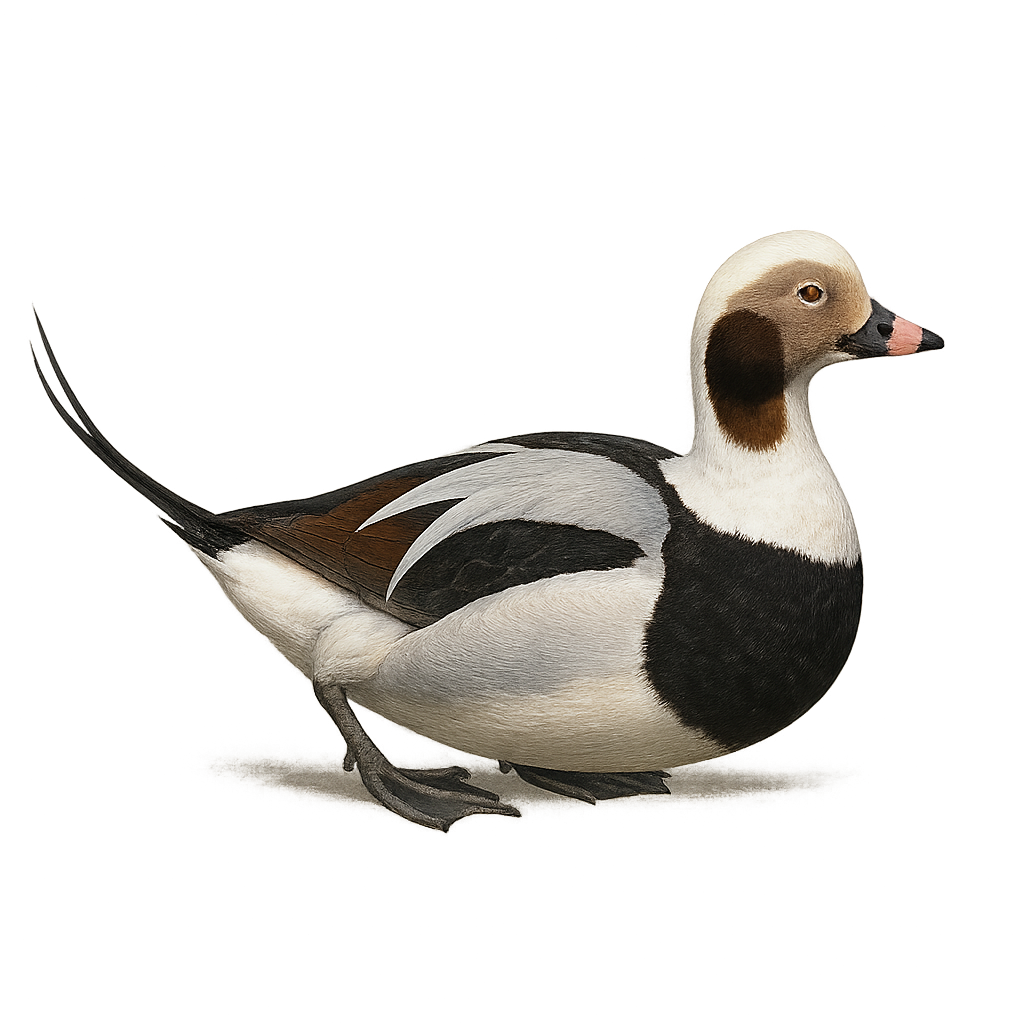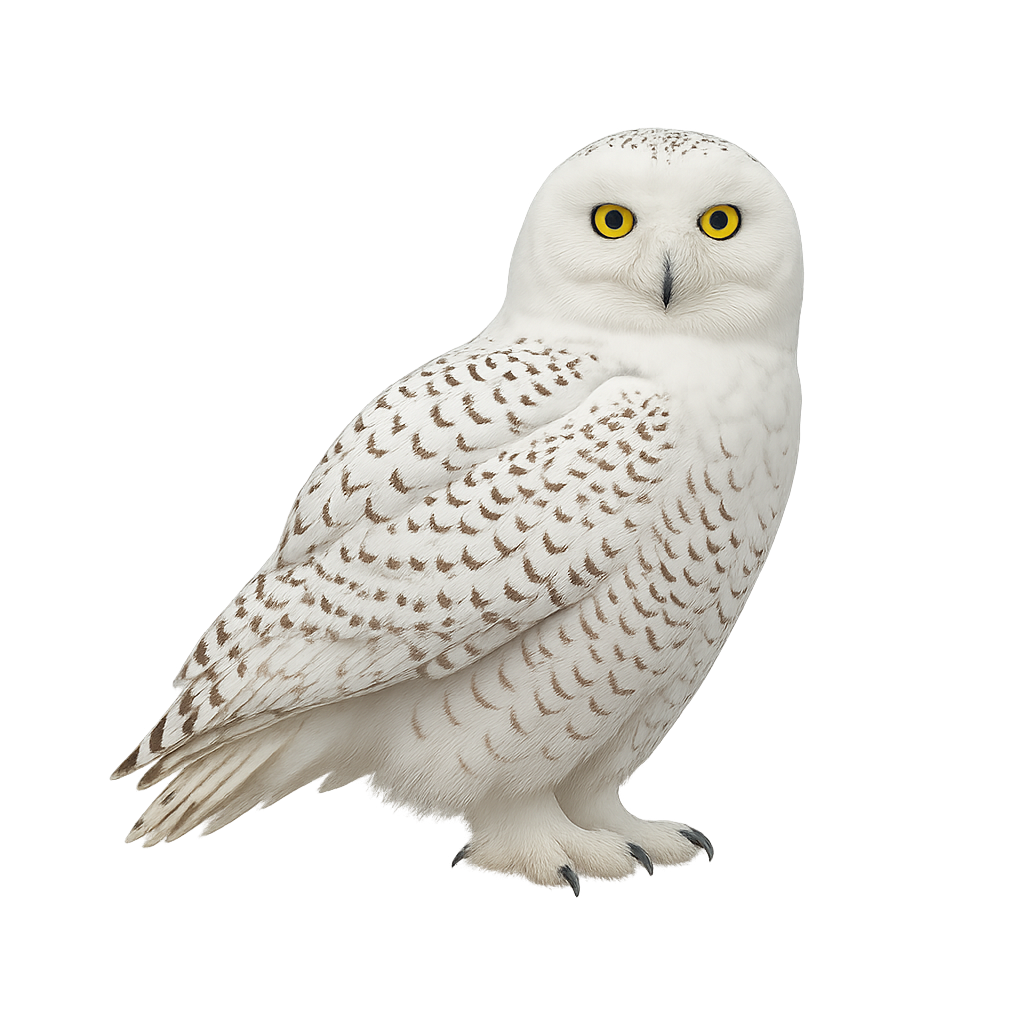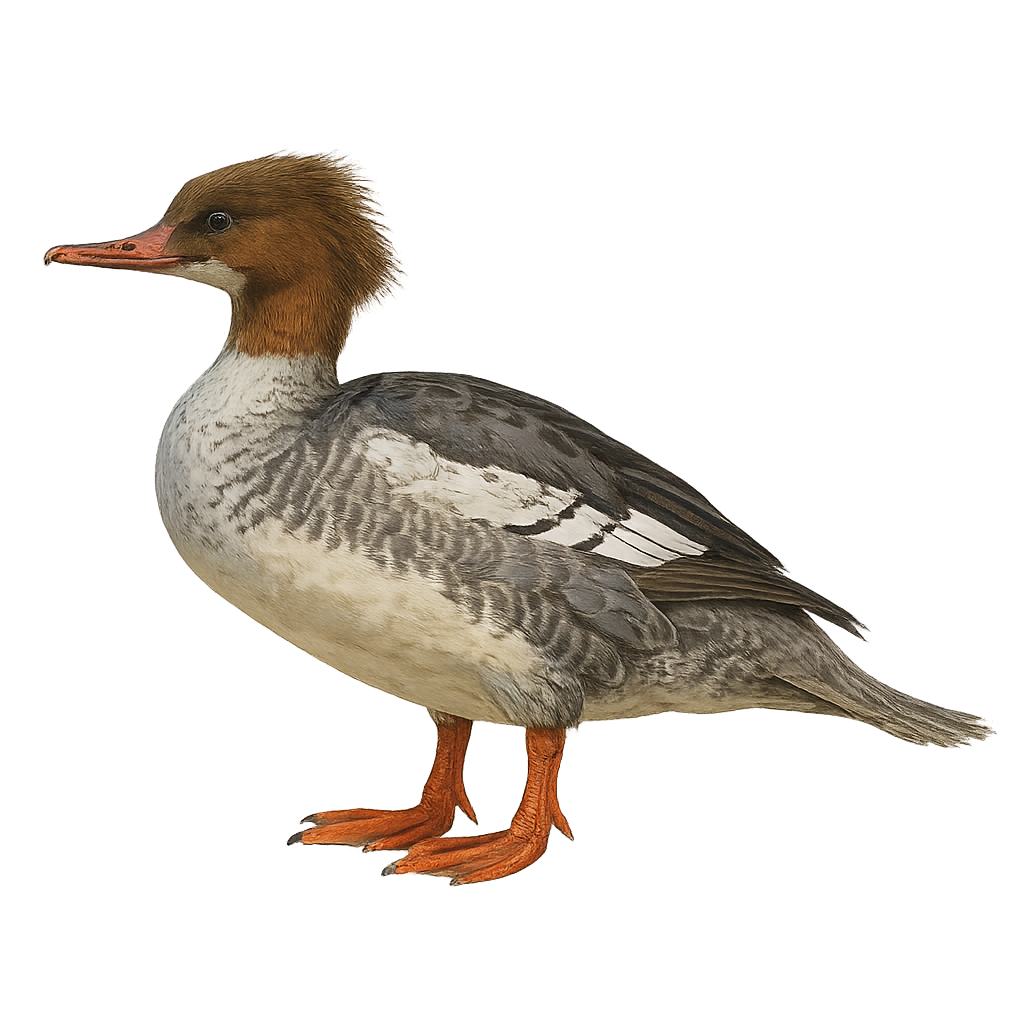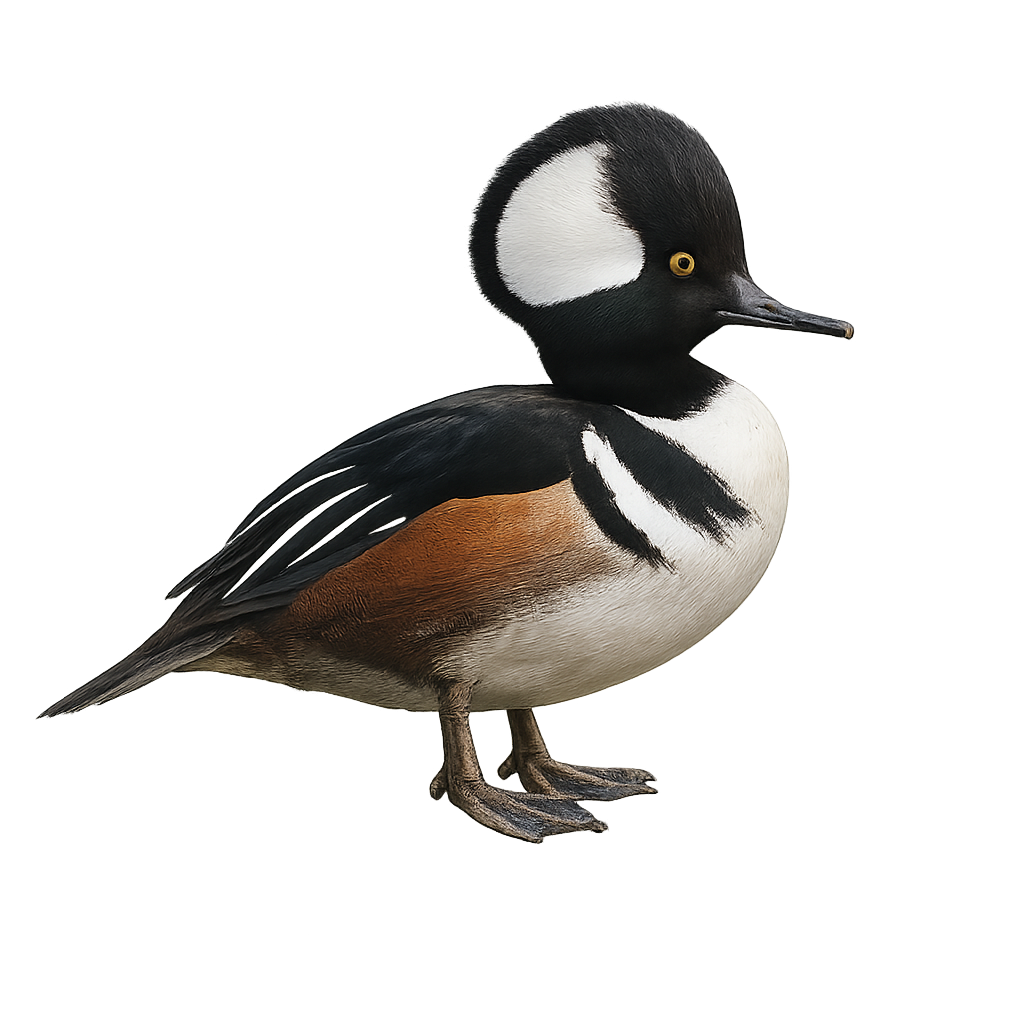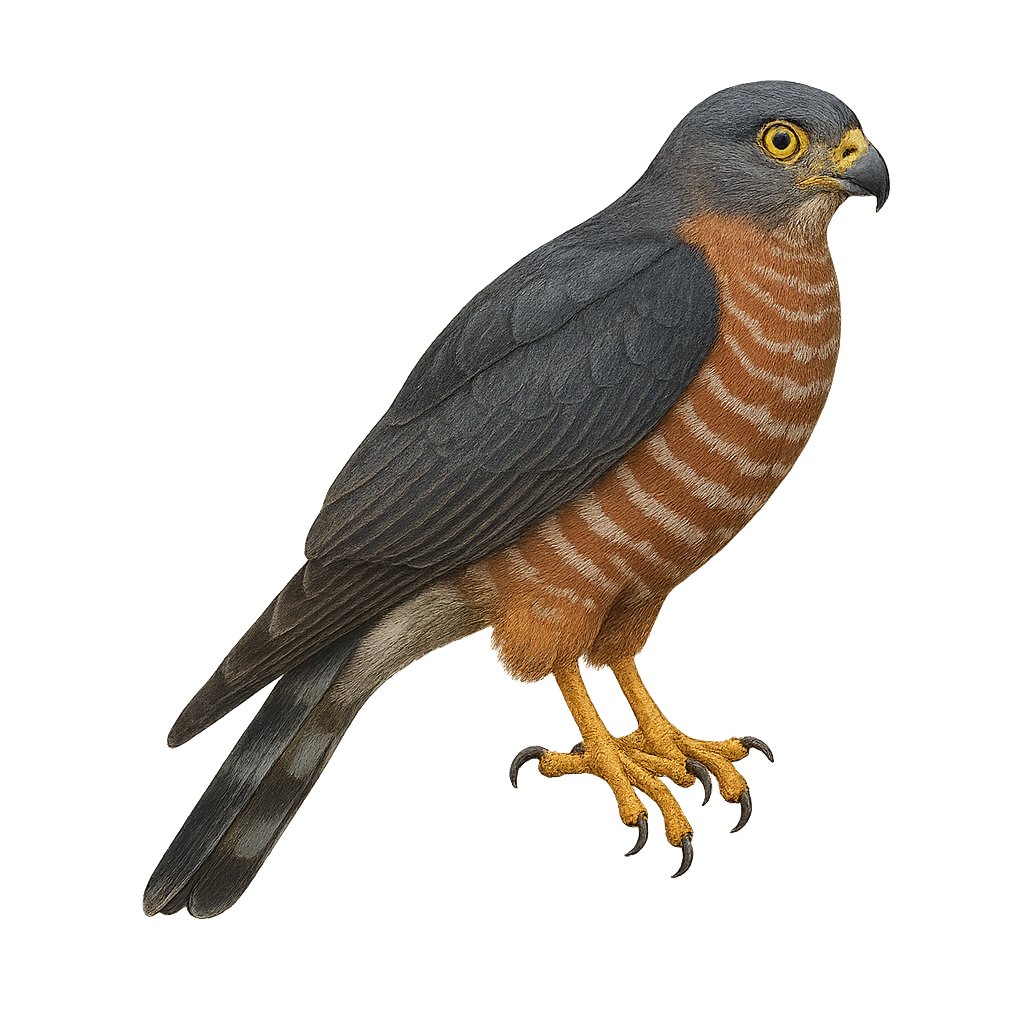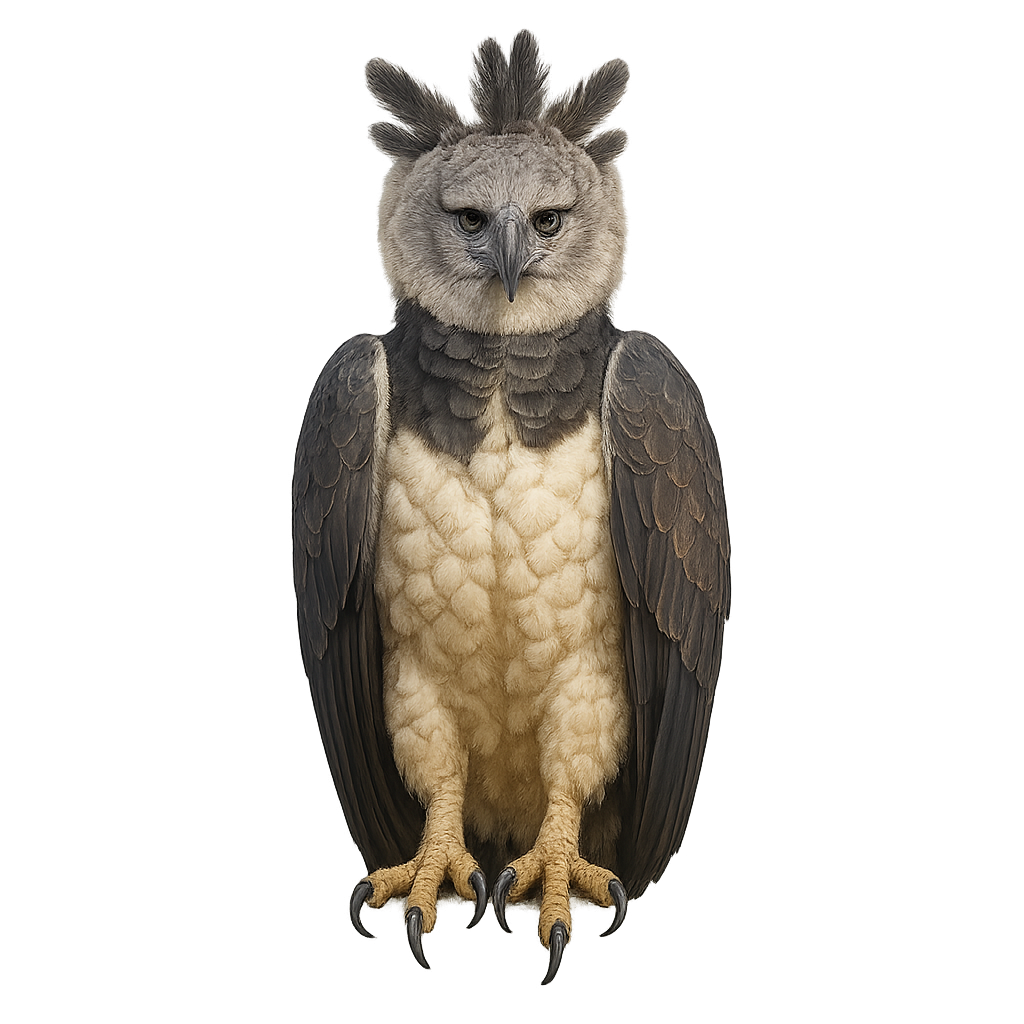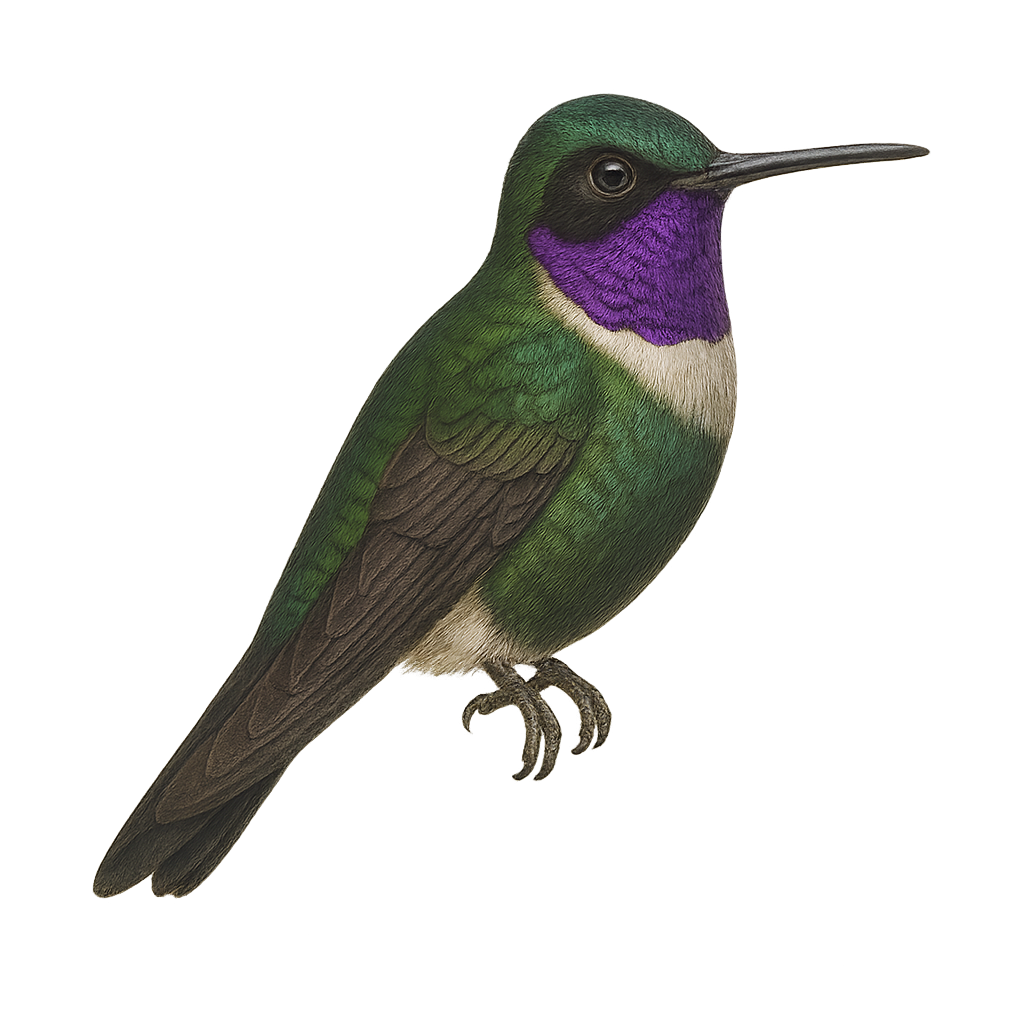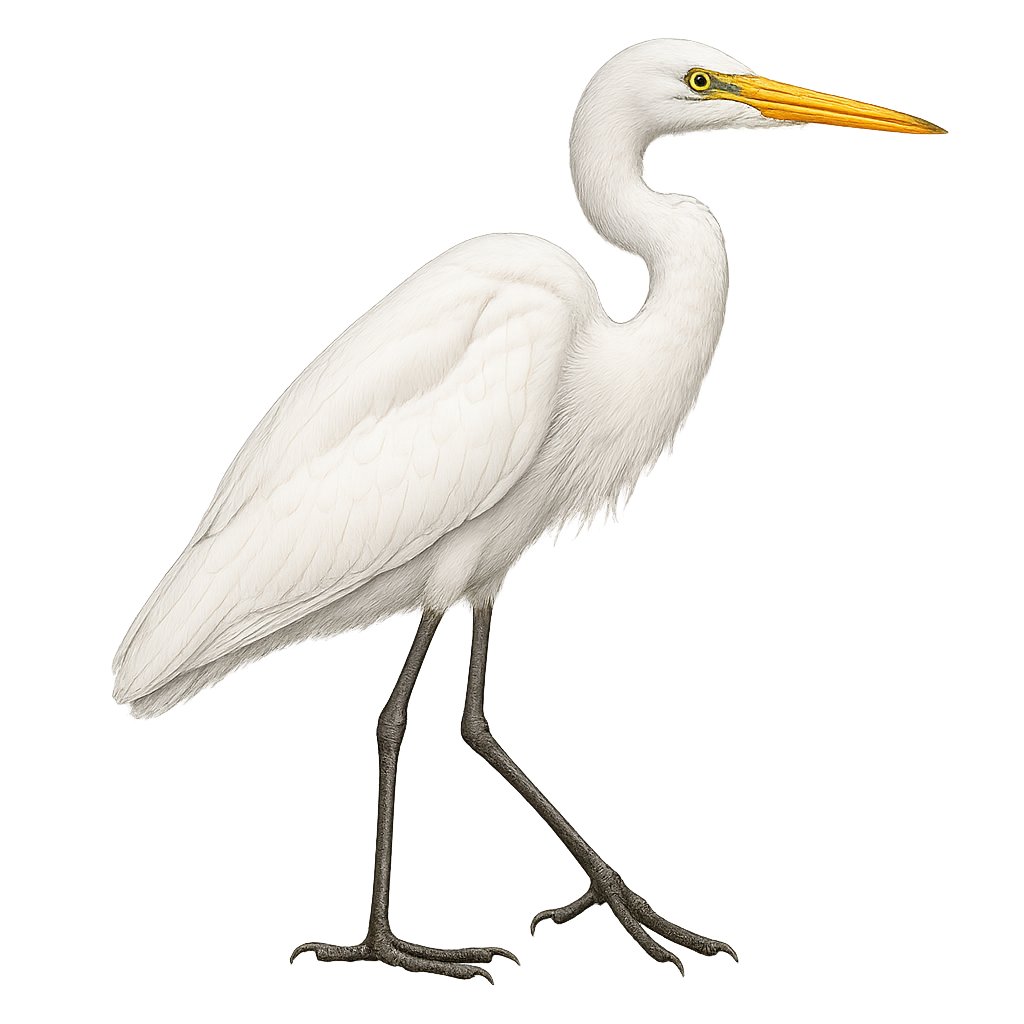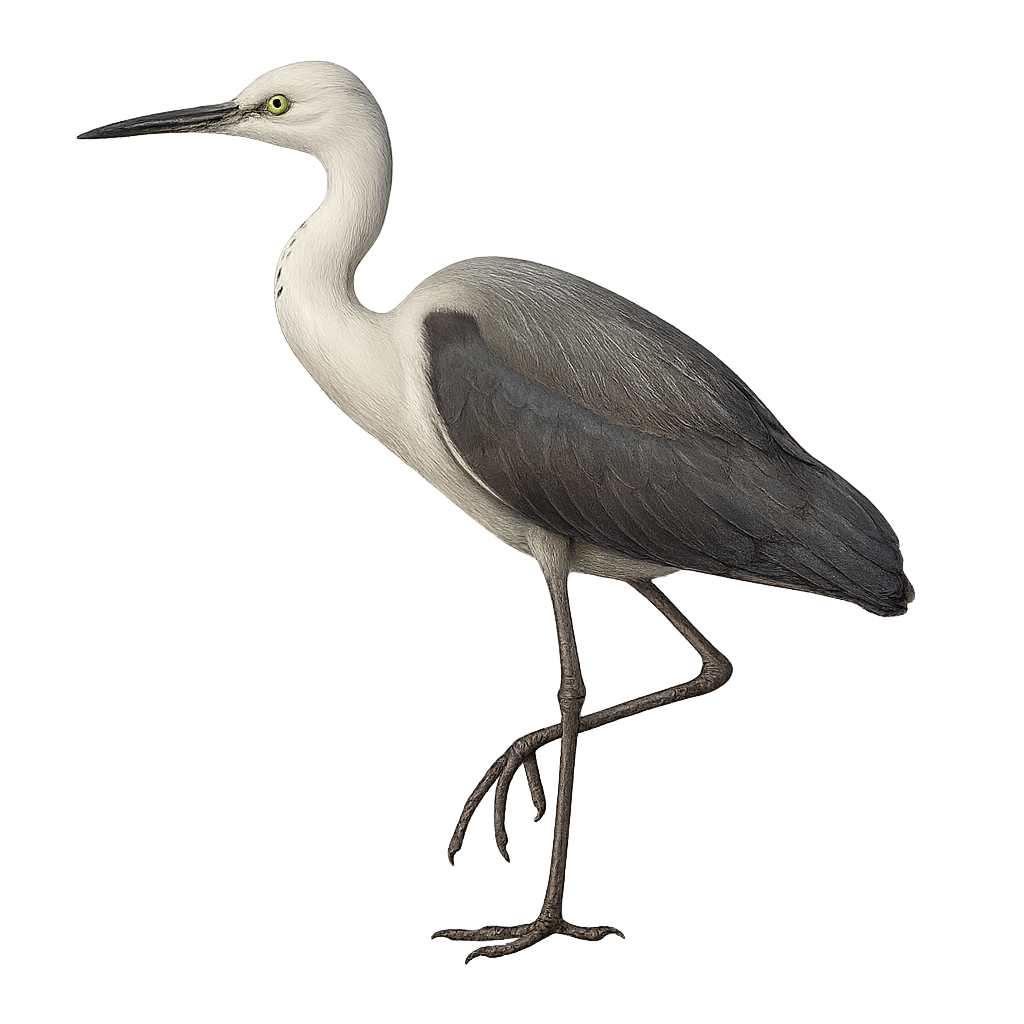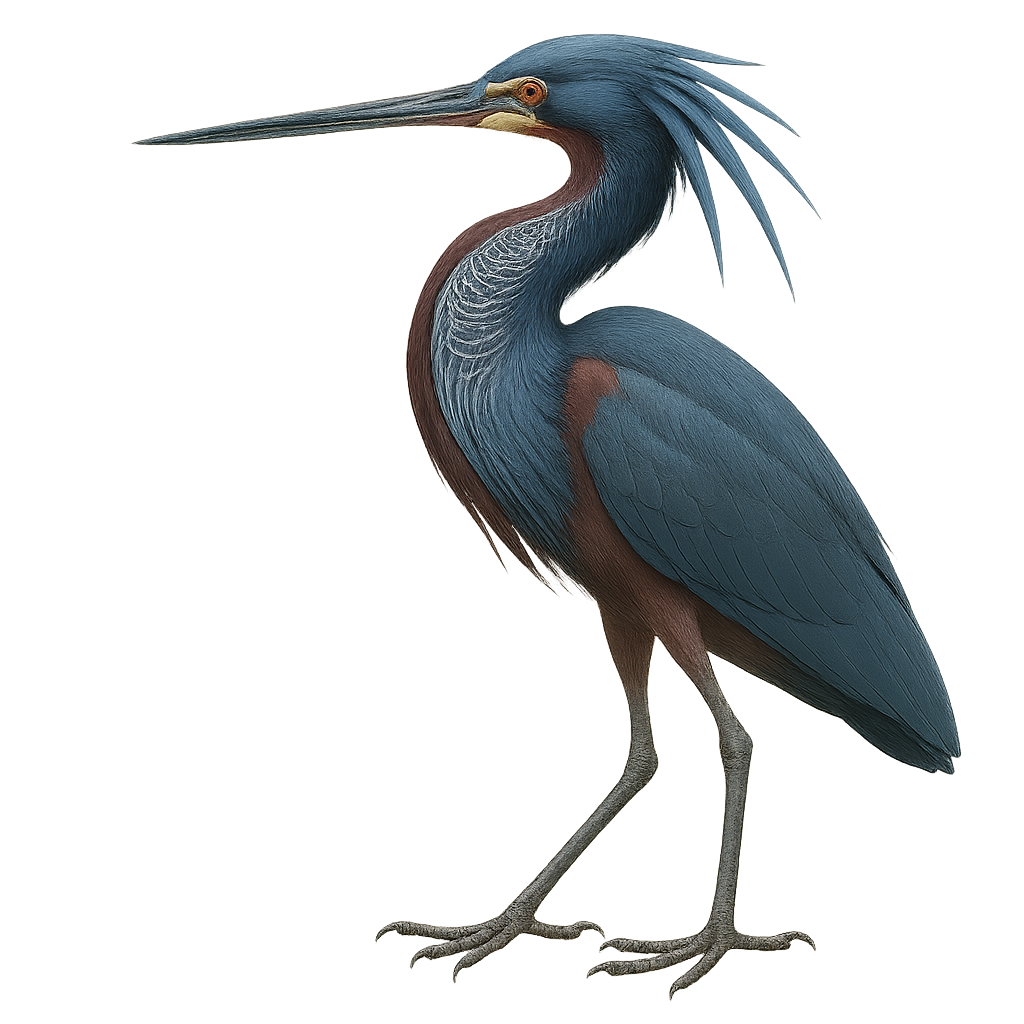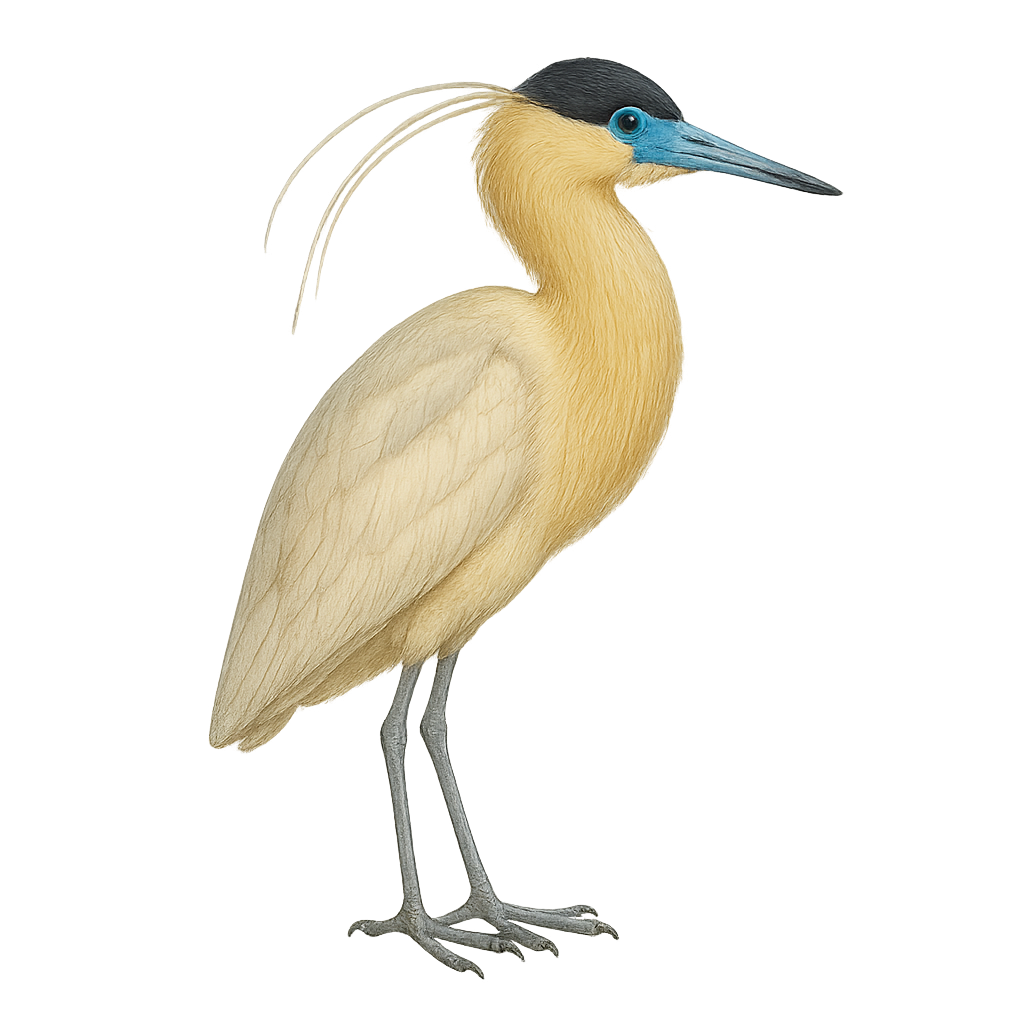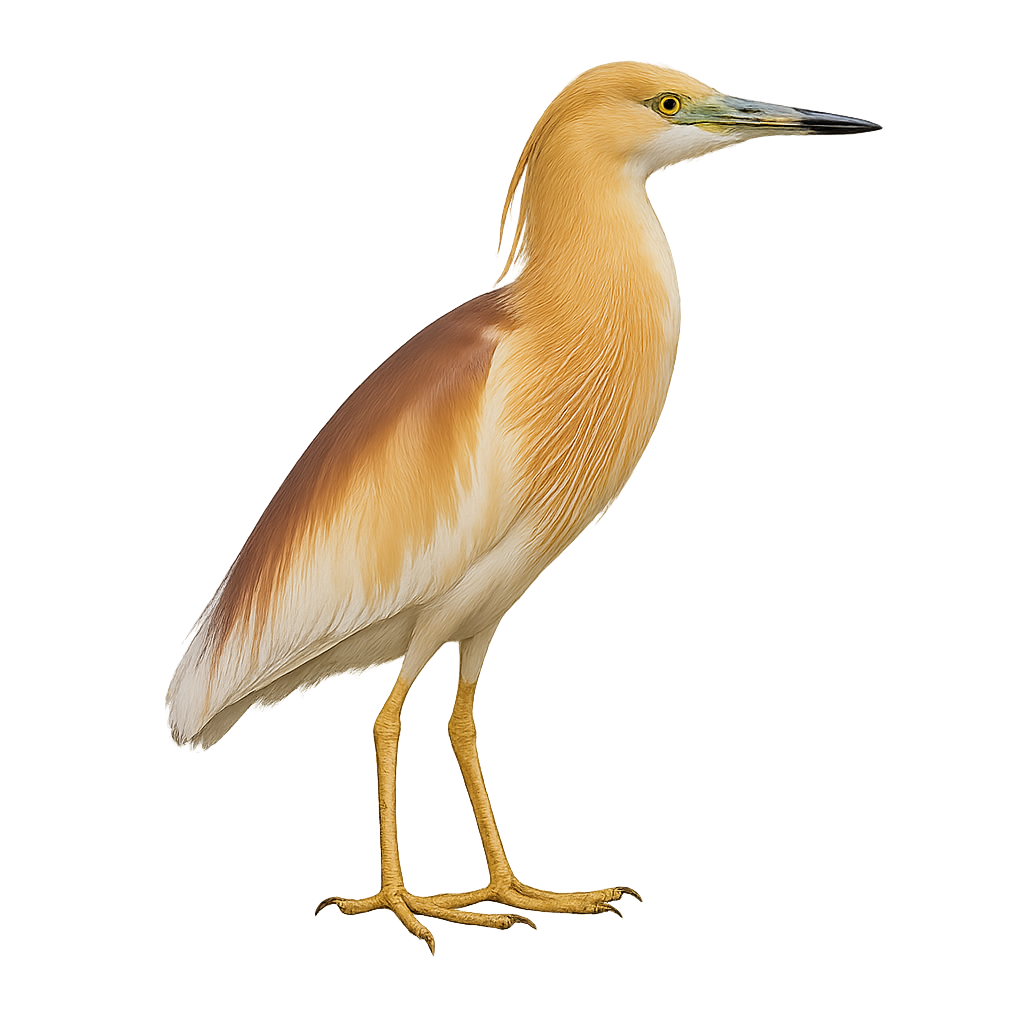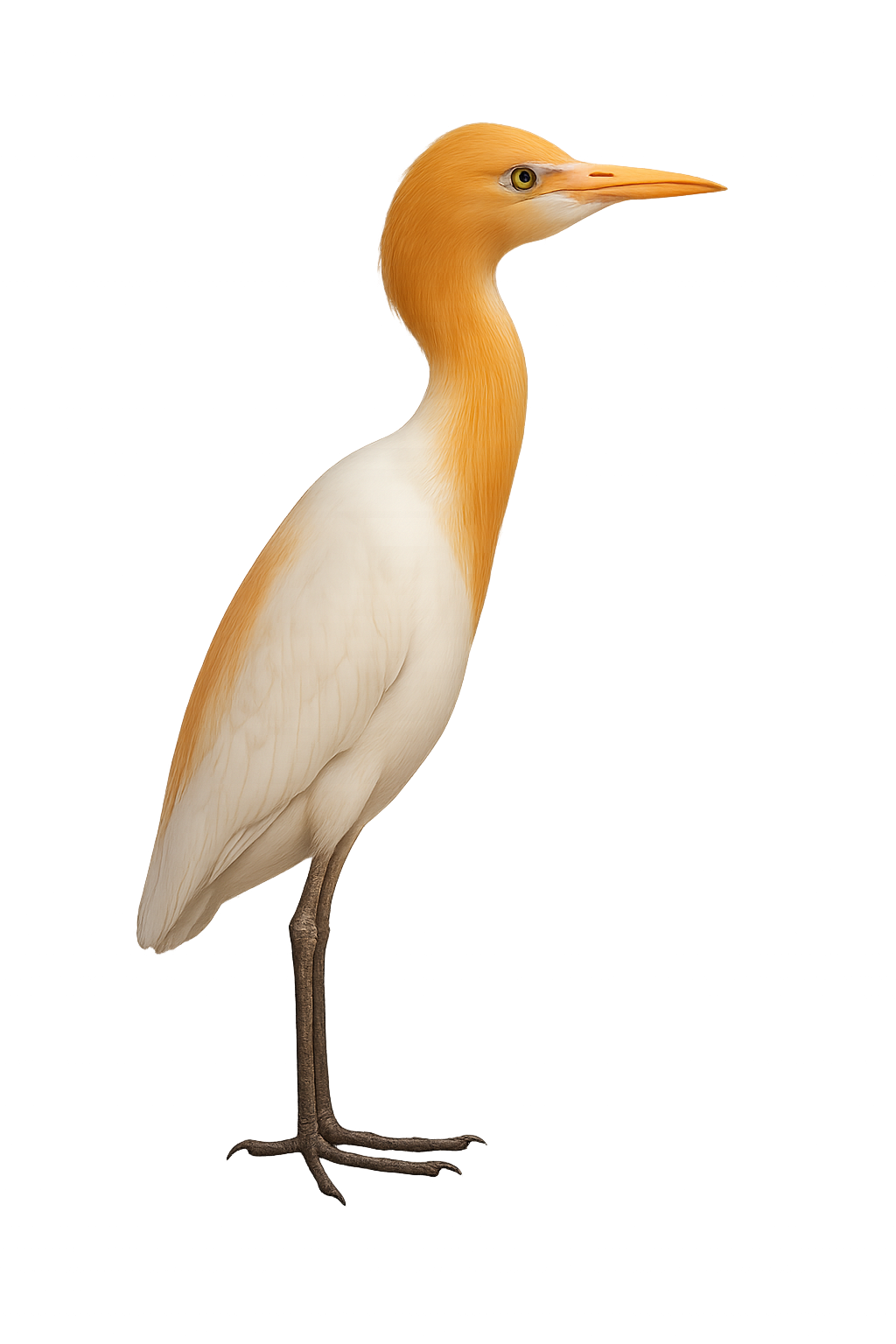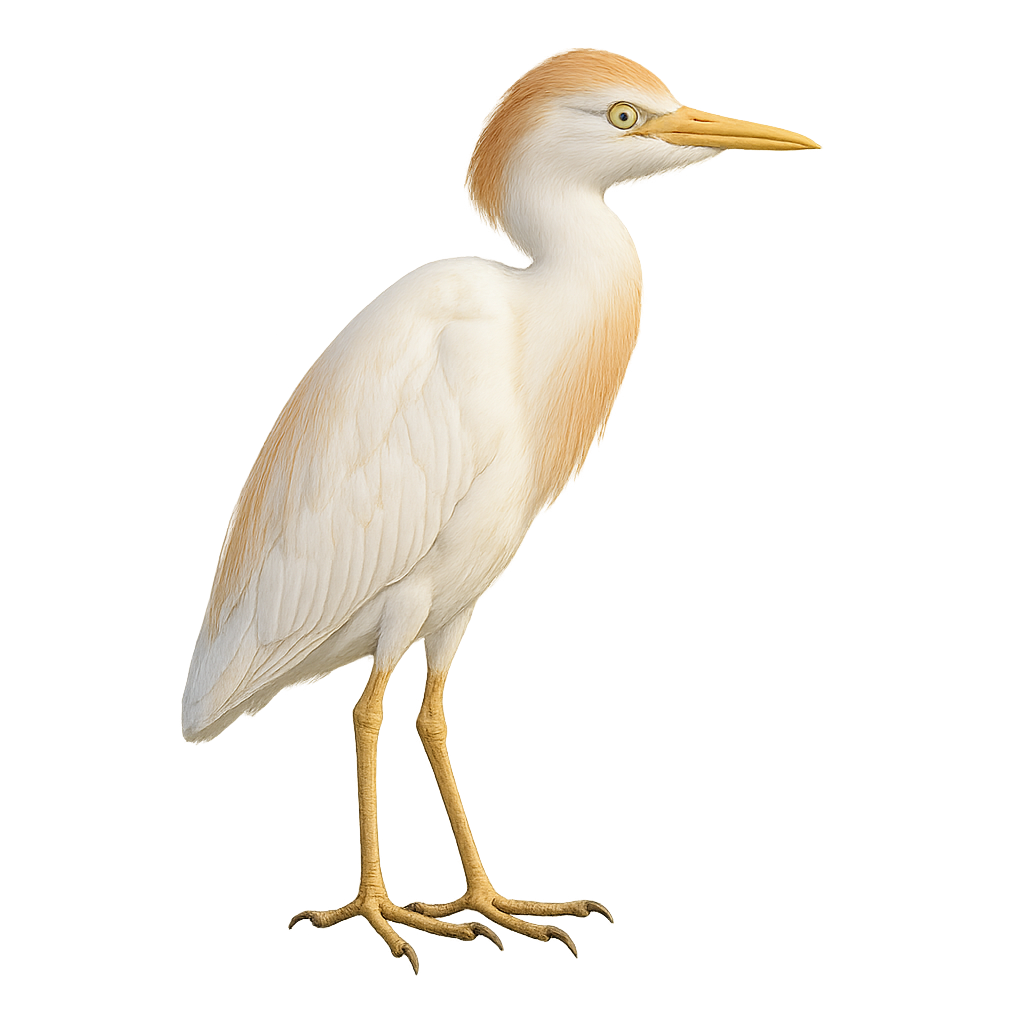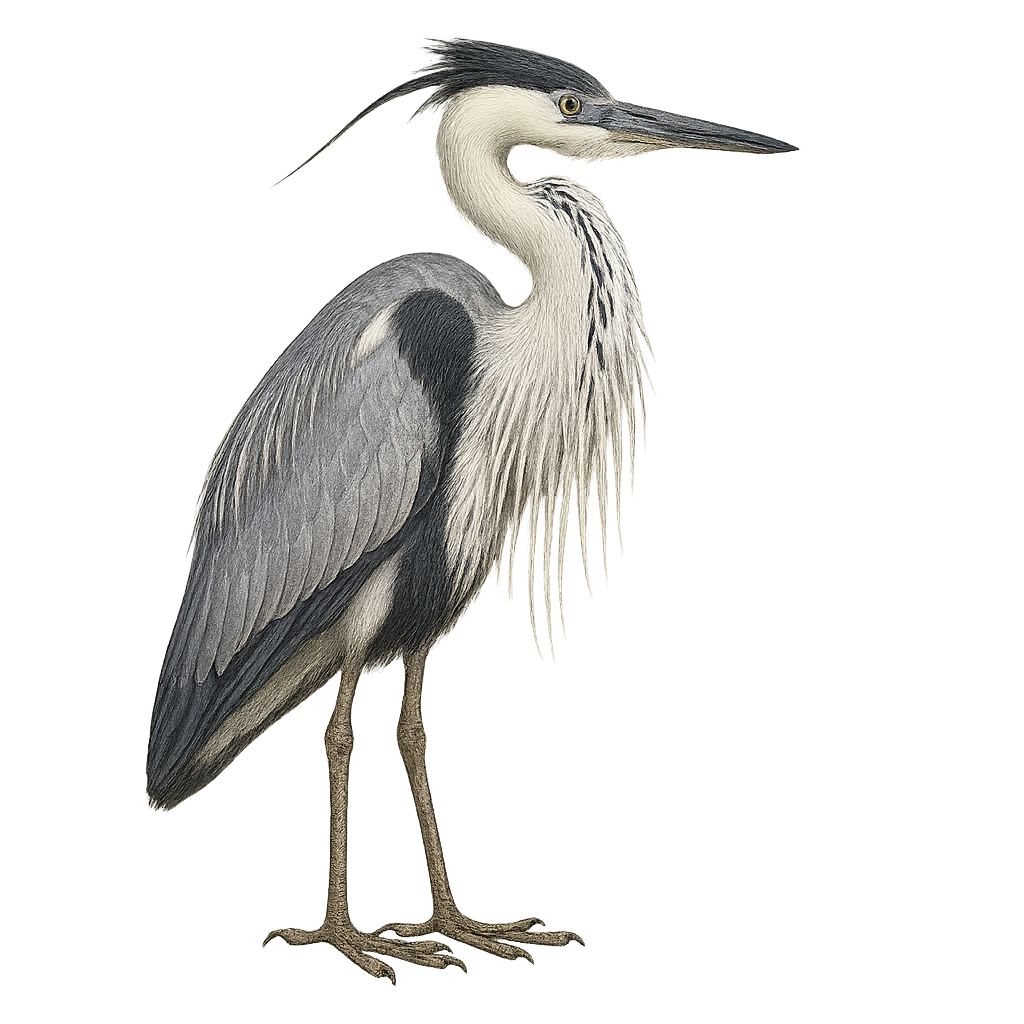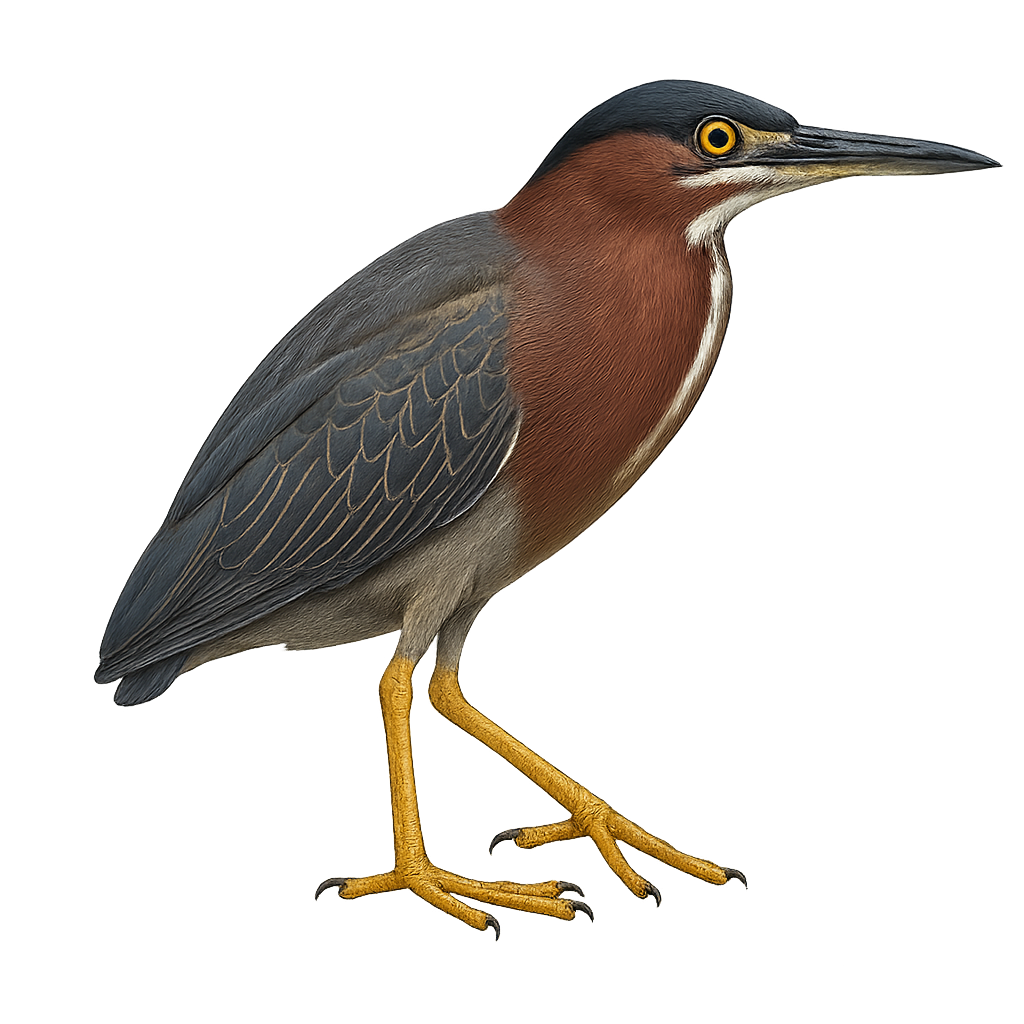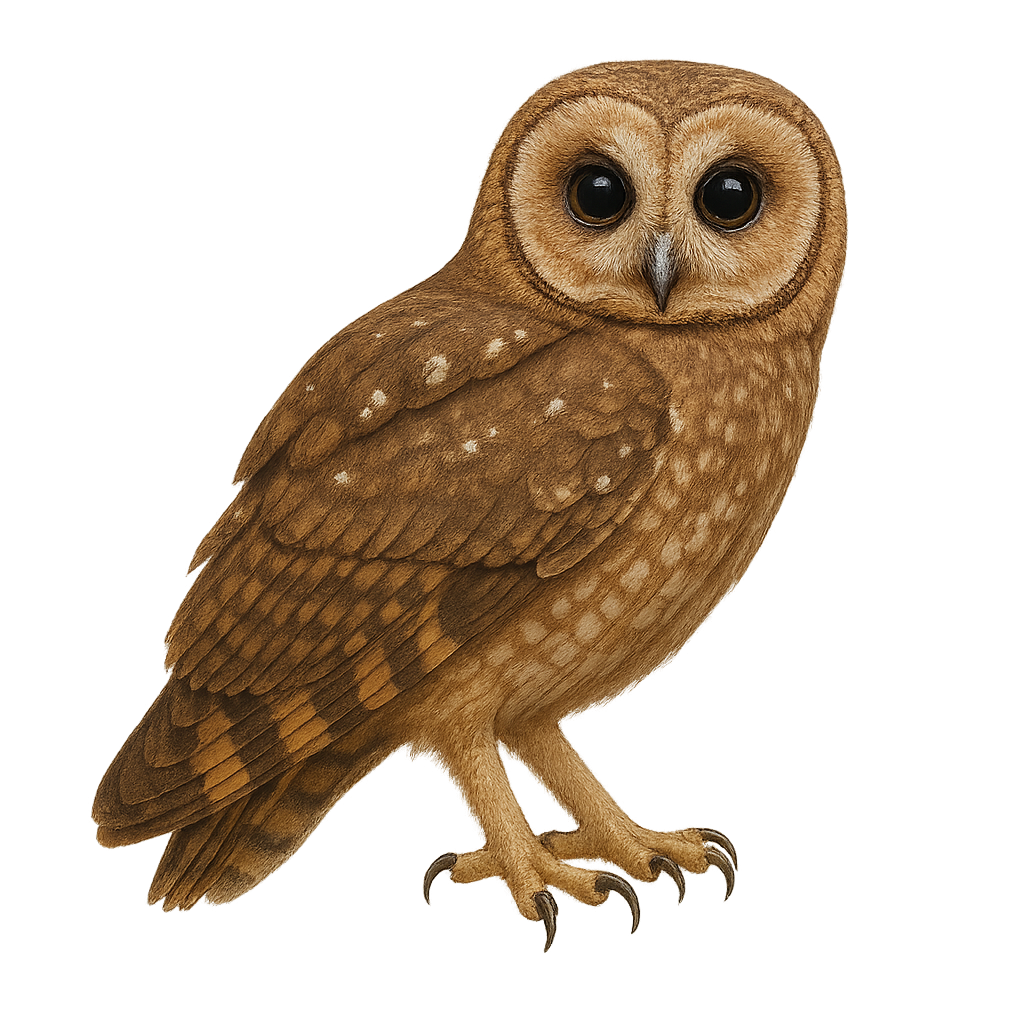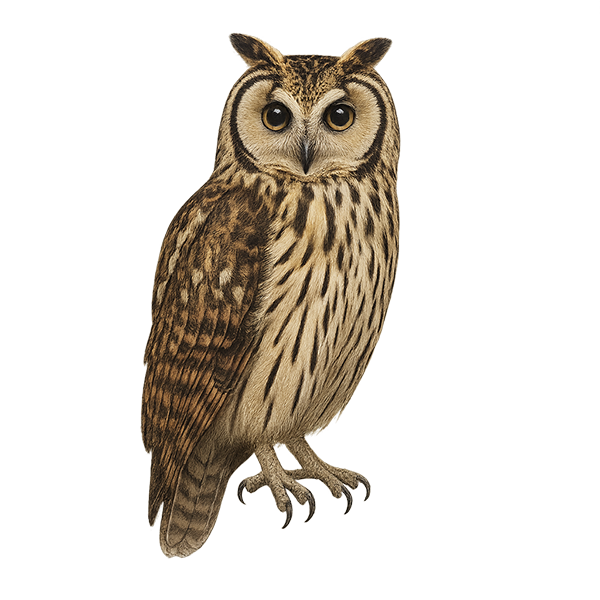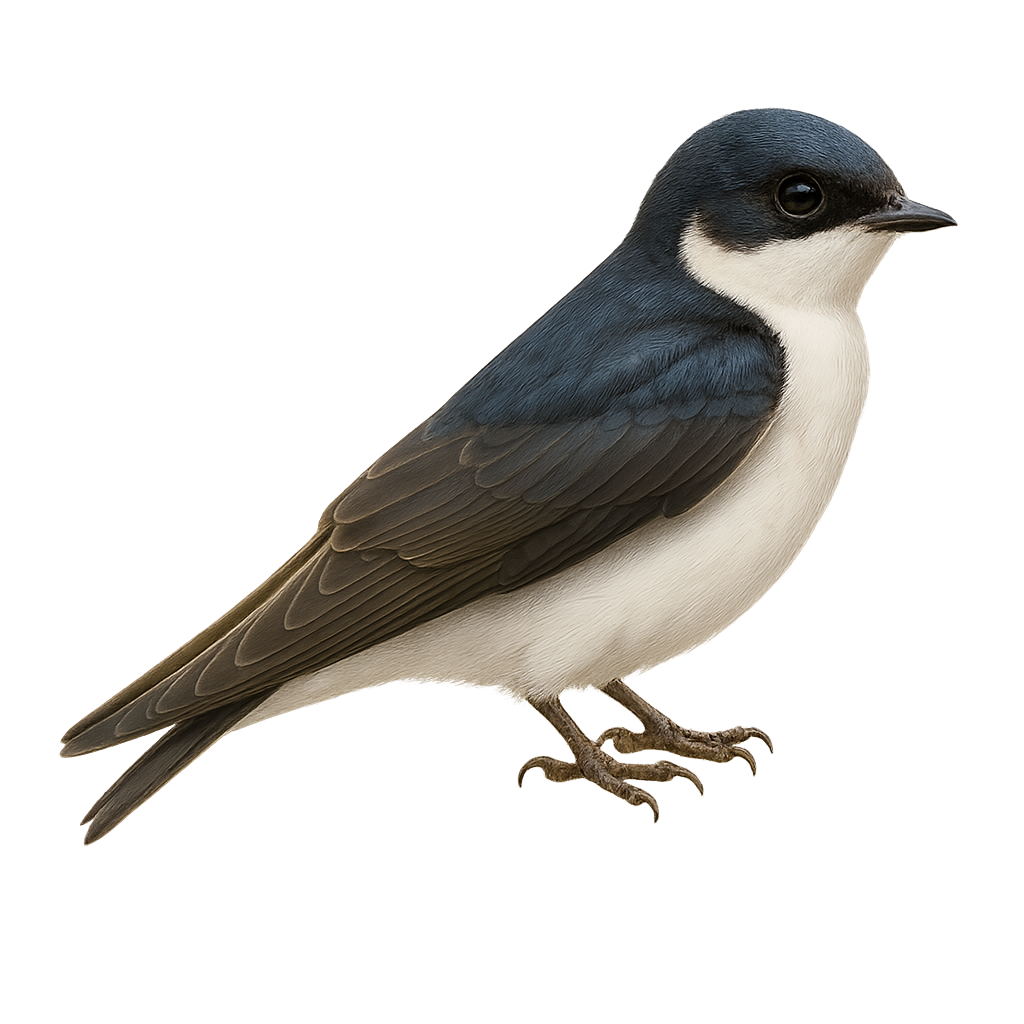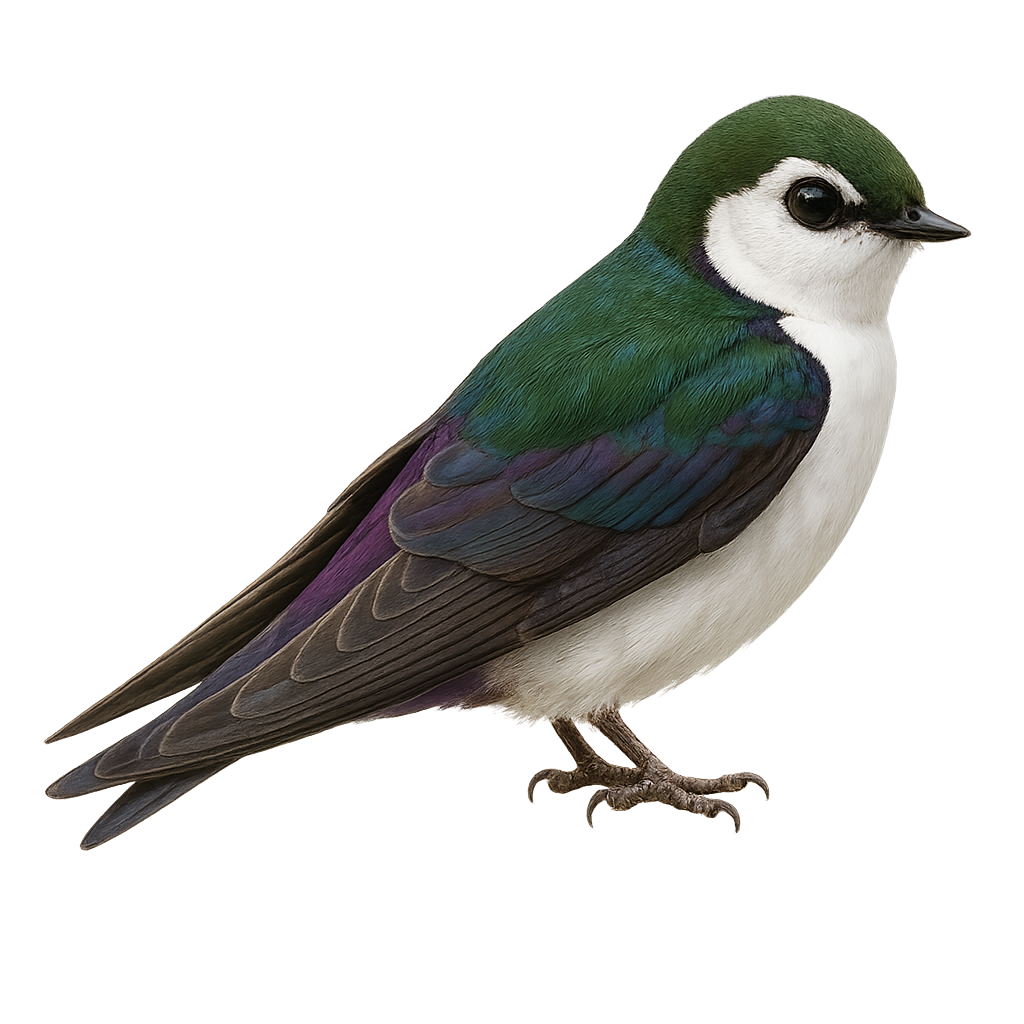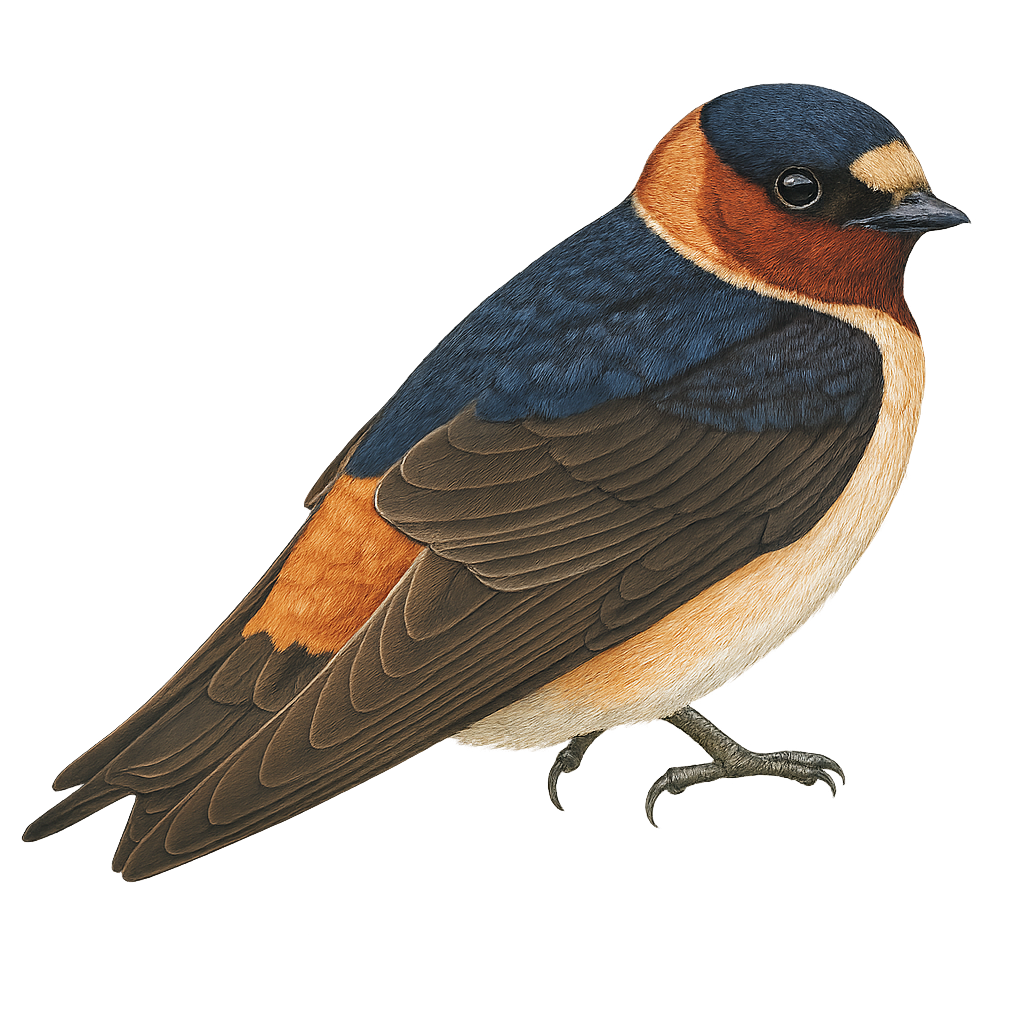The Common Eider is a medium-sized seabird, easily recognizable by its distinctive plumage and diving behavior. It measures about 40 cm in length, with a wingspan of 65 to 75 cm, and weighs between 500 and 900 g. Its plumage is primarily black and white, with a black head, a wide white band around the neck, and white spots on the wings. The male, during the breeding season, has a bright orange beak and a distinctive white line running from the beak to the back of the head. The Common Eider primarily inhabits the cold waters of the North Atlantic, notably around the coasts of Iceland, Greenland, Canada, and Northern Europe. It is an excellent diver, feeding mainly on small fish, crustaceans, and marine invertebrates, which it captures underwater. The Common Eider migrates southward during the winter. Although the species is not currently endangered, it is vulnerable to marine pollution, climate change, and disturbance of its breeding sites.
The Snowy Owl is a large nocturnal raptor, easily recognizable by its pure white plumage, speckled with dark spots on its back and wings. It measures about 55 to 65 cm in length, with a wingspan of 1.3 to 1.5 meters, and weighs between 1.5 and 2.5 kg. Its head is round, with large, piercing yellow eyes and a short, hooked beak. The Snowy Owl primarily inhabits the Arctic regions, notably in Canada, Alaska, Scandinavia, and Russia, where it frequents tundras and snowy landscapes. It primarily feeds on small mammals, such as lemmings, but also hunts birds and occasionally fish. This raptor is an excellent hunter, capable of spotting its prey with its keen vision, even in low light conditions. Although the Snowy Owl is not currently endangered, it is sensitive to climate change and the loss of its natural habitat.
The Common Merganser is a large diving duck measuring between 58 and 71 cm in length, with a wingspan of 82 to 97 cm. The male features a dark green iridescent head, white body, and black back, while the female has a reddish-brown crested head and light gray body. This duck is characterized by its long, slender red bill with serrated edges, ideal for catching slippery fish. It inhabits clear-water rivers and lakes in forested regions of Europe, Asia, and North America. Nesting in tree cavities or cliff crevices, it lays between 6 and 17 eggs per season. Its diet mainly consists of fish, but also includes amphibians, crustaceans, and aquatic insects. Although listed as Least Concern, habitat loss can locally impact its populations.
The Hooded Merganser is a medium-sized duck, easily recognizable by its distinctive crest and vibrant colors. It measures about 40 to 50 cm in length, with a wingspan of 60 to 70 cm, and weighs between 400 and 700 g. The male, during the breeding season, has a black and white head with an impressive crest of white feathers on top. Its plumage is mainly black and white, with shades of brown and green, and it has a short, wide beak adapted for feeding on fish, crustaceans, and aquatic invertebrates. The female, on the other hand, is more subtle, with light brown plumage and a less prominent crest. The Hooded Merganser primarily inhabits North America, particularly in the northeastern United States, where it frequents lakes, rivers, and wetland areas. It is an excellent diver, capable of diving underwater to capture its prey. Although the species is not in immediate danger, it is vulnerable to habitat loss and water pollution.
The Red-breasted Merganser is a slender diving duck, measuring about 52 to 58 cm in length with a wingspan of 67 to 82 cm. The male features a dark green head with a shaggy crest, a white collar, a rusty speckled chest, and a thin red bill. The female has a reddish-brown head with a more subdued crest, a grayish body, and a duller red bill. This duck inhabits coastal waters, estuaries, bays, and large lakes, favoring saline or brackish areas. It primarily feeds on small fish, but also consumes crustaceans, aquatic insects, and amphibians, captured using its serrated bill adapted for fishing. A migratory species, it nests on the ground near water, often concealed under vegetation or in rocky crevices. Although listed as Least Concern by the IUCN, the Red-breasted Merganser is sensitive to water pollution, coastal habitat destruction, and human disturbances.
The Double-toothed Kite, or Harpagus bidentatus, is a medium-sized raptor found mainly in the tropical forests of Central and South America. It is easily recognizable by its grayish plumage and short, rounded wings, which allow it to maneuver skillfully through dense forest canopies. This bird of prey primarily feeds on reptiles, insects, and occasionally small mammals. Its name comes from the two prominent teeth on its beak, which help it grasp and tear its prey. The Double-toothed Kite is often observed following groups of capuchin monkeys, taking advantage of the commotion they cause to catch frightened prey.
The Harpy Eagle is one of the most powerful and impressive raptors in the world, easily recognizable by its large size and distinctive crest of feathers on its head. It measures between 86 and 107 cm in length, with a wingspan of 2 to 2.3 meters, and weighs between 6 and 10 kg. Its plumage is primarily dark gray and black, with white spots on the wings and belly, and a head adorned with a crest of feathers, giving it an imposing appearance. The Harpy Eagle primarily inhabits the tropical rainforests of Central and South America, notably in Mexico, Panama, Colombia, and Brazil. Carnivorous, it primarily feeds on mammals such as monkeys, sloths, and coatis, which it captures in flight or on trees with its powerful talons. Although the Harpy Eagle is not yet critically endangered, its population is threatened by deforestation, habitat loss, and illegal hunting.
The Heliangelus amethysticollis, or Amethyst-throated Sunangel, is a captivating small bird from the Trochilidae family. This hummingbird is distinguished by its striking violet throat, which beautifully contrasts with its metallic green plumage. It is primarily found in the humid forests of the Andes, at altitudes ranging from 1800 to 3000 meters. Its slender, slightly curved beak is perfectly adapted for feeding on flower nectar, which it gathers with remarkable agility. In addition to its nectarivorous diet, it also consumes small insects to supplement its nutrition. The Amethyst-throated Sunangel is a territorial bird, often observed vigorously defending its territory against other hummingbirds. Its breeding season generally extends from November to March, and the female builds a cup-shaped nest where she lays two eggs.
The Yellow-billed Egret, or Ardea brachyrhyncha, is a graceful and slender bird, primarily white with a distinctive yellow bill. It primarily inhabits the wetlands of sub-Saharan Africa, favoring marshes, rivers, and lakes. Its immaculate white plumage contrasts with its long black legs, ideal for wading in shallow waters in search of prey. This heron is an opportunistic hunter, feeding mainly on fish, amphibians, and aquatic insects. Although generally solitary, it can be seen in small groups during the breeding season. Its flight is graceful, with slow wing beats and a retracted neck.
The White-faced Heron is a graceful and slender bird, identifiable by its bluish-grey plumage and distinctive white face. It is common in Australia, New Zealand, and parts of Southeast Asia. This heron frequents a variety of wetland habitats, including marshes, rivers, and coasts. It primarily feeds on fish, aquatic insects, and small crustaceans. Its flight is graceful, with slow and steady wing beats. The White-faced Heron is often seen alone or in small groups and is known for its ability to remain still for long periods while waiting for prey.
The Agami Heron, or Agamia agami, is a unique and fascinating heron known for its exceptionally colorful plumage and slender silhouette. This large bird, measuring about 66 to 76 cm in length, sports a plumage with varied hues ranging from deep blue to brown, with metallic reflections. Its neck is long and thin, often folded in an S-shape, and its beak is sharp, ideal for capturing aquatic prey. The Agami Heron is primarily observed in the humid tropical forests of Central and South America, where it frequents rivers and swamps. Discreet and solitary, it is often difficult to spot, preferring to move slowly and silently through dense vegetation.
The Grey Heron is a large wading bird, easily recognizable by its slender silhouette, long neck, and large legs. It stands about 90 cm tall, with a wingspan of 1.5 to 1.9 meters, and weighs between 1.5 and 2 kg. Its plumage is primarily gray, with white markings on the belly and underside of the wings, and a white head adorned with distinctive black feathers. It has a long, pointed yellow beak, adapted for capturing its prey, primarily fish, amphibians, insects, and occasionally small mammals. The Grey Heron inhabits wetlands, marshes, rivers, and lakes across Europe, Asia, and North Africa. It is an excellent hunter, patiently waiting by the water's edge to capture its prey with its beak. Although the species is not endangered, it can be vulnerable to water pollution, habitat loss, and human disturbance.
The capped heron, or Pilherodius pileatus, is an elegant and distinctive bird, recognizable by its black head contrasting with its white body and long blue bill. It primarily inhabits the humid tropical forests of Central and South America, often near slow-moving rivers and swamps. This solitary bird is often seen fishing, using its patient hunting technique to catch fish and small invertebrates. Its breeding season varies by region but is generally associated with the rainy season when food is abundant. Although its conservation status is currently stable, deforestation and habitat loss pose potential threats to its populations.
The Indian pond heron is a small heron of about 45 cm, with buff-brown plumage and white flight feathers visible in flight. It inhabits freshwater wetlands, rice paddies and riverbanks, standing motionless before striking fish, amphibians and insects with a quick bill thrust. During breeding, it builds a stick nest in waterside shrubs and the male performs courtship displays by raising neck feathers.
The Purple Heron, or Ardea coromanda, is a large, slender wading bird distinguished by its rich reddish-brown plumage and long neck. It inhabits rice fields, swamps, wooded wetlands, and lake edges across East and Southeast Asia. This heron is partially migratory, with seasonal movements depending on climate conditions. Typically solitary, it hunts slowly in shallow waters, feeding mainly on fish, amphibians, and aquatic invertebrates. The population is considered stable overall, although local declines may occur due to wetland loss.
The Whistling Heron, Syrigma sibilatrix, is an elegant and distinctive bird, recognizable by its pastel-colored plumage and long, graceful neck. It features a blue-gray head with a black crown, while its body displays shades of beige and pink. This heron is often found in wetlands, marshes, and flooded grasslands of South America, where it primarily feeds on small fish, insects, and crustaceans. Its name comes from its characteristic call, a melodious whistle that echoes through its natural habitat. Although generally solitary, it can be seen in small groups during the breeding season.
The Cattle Egret is a small heron with primarily white plumage, featuring touches of yellow on the neck and head during the breeding season. It measures about 55 to 60 cm in length, with a wingspan of 90 to 100 cm, and weighs between 300 and 500 g. This heron is notable for its social behavior, often seen in the company of large herds of cattle or near farm animals, hence its name "cattle egret." It takes advantage of the presence of these animals to hunt insects, worms, and other small animals disturbed by the movement of livestock. The Cattle Egret primarily inhabits Africa, Asia, and parts of Europe, such as the Mediterranean. It feeds mainly on small invertebrates, insects, and occasionally small fish, and is particularly efficient in agricultural and wetland areas. Although the species is widely spread, it may be vulnerable to habitat loss and changes in farming practices.
The White-bellied Heron, Ardea insignis, is a rare and majestic bird primarily found in the Himalayan regions. It is distinguished by its grey-blue plumage and white belly, contrasting with its long neck and slender legs. Standing up to 127 cm tall, it is one of the largest herons in the world. Preferring high-altitude rivers and lakes, it is often solitary and discreet, making it difficult to observe. Its population is declining, mainly due to habitat loss and human disturbance. Conservation efforts are crucial to ensure its survival, as it is classified as critically endangered by the IUCN.
The Purple Heron is a large wading bird, easily recognizable by its colorful plumage, ranging from purple to reddish, with shades of brown and blue. It measures about 80 to 100 cm in length, with a wingspan of 1.3 to 1.5 meters, and weighs between 600 and 1,200 g. Its beak is long, thin, and pointed, with a yellowish-green color, while its legs are long and gray. During the breeding season, the Purple Heron sports decorative plumes on its head and neck. It primarily inhabits wetlands, marshes, rivers, and lakes across Europe, Africa, and Asia, where it feeds on fish, crustaceans, small mammals, and occasionally insects. It primarily hunts at night or during twilight, using its great agility to capture prey in the water. Although the species is not immediately endangered, it is vulnerable to habitat loss, water pollution, and human disturbance.
The Striated Heron, or Butorides striata, is a small heron with predominantly grey-green plumage, a black cap, and yellow legs. It is often seen in wetlands, mangroves, and along rivers. This heron is an opportunistic feeder, primarily consuming fish, insects, and small crustaceans. It employs a unique hunting technique, remaining still before quickly striking its prey. Although generally solitary, it can sometimes be seen in small groups. Its ability to adapt to various aquatic habitats allows it to inhabit a wide range of geographical regions, from tropical to temperate areas.
The Green Heron, Butorides virescens, is a small heron with dark green plumage and bluish-gray wings. It is characterized by its dark head and long, pointed bill. This heron is often found in wetlands, marshes, and along the shores of water bodies in North and Central America. Known for its clever hunting technique, it uses bait to lure fish. The Green Heron is a solitary bird but can be seen in small groups during migration. It is generally discreet and blends well into its environment. Its breeding season extends from spring to summer, where it builds its nest in trees or shrubs near water.
The Short-eared Owl is a small nocturnal raptor, easily recognizable by its pale yellowish plumage and large, piercing yellow eyes. It measures about 34 to 40 cm in length, with a wingspan of 80 to 95 cm, and weighs between 180 and 400 g. Its face is disc-shaped, like that of other owls, and its plumage, which is cream or brown, is speckled with dark spots that provide excellent camouflage in the grasslands and marshes where it resides. The Short-eared Owl primarily inhabits open areas, such as marshes, grasslands, and farmland, across Europe, Asia, and North America. It mainly hunts small mammals, such as voles and mice, as well as birds and insects. This raptor is an excellent nocturnal hunter, using its very sensitive ears and sharp vision to locate prey in the dark. Although the species is not immediately endangered, it is vulnerable to habitat loss, water pollution, and human disturbance.
The Cape Owl, Asio capensis, is a species of nocturnal bird of prey belonging to the Strigidae family. This owl is characterized by its brown plumage speckled with white and black, allowing it to blend seamlessly into its natural habitat. It has long tufts on its head, often erect, and piercing yellow eyes. It is primarily found in the wetlands, marshes, and savannas of sub-Saharan Africa. This owl is an opportunistic hunter, feeding mainly on small mammals, birds, and insects. Although its conservation status is concerning due to habitat loss, it remains relatively widespread in some areas.
The Long-eared Owl is a medium-sized nocturnal raptor, easily recognizable by its large tufts of feathers shaped like "ears" on its head. It measures about 35 to 40 cm in length, with a wingspan of 85 to 100 cm, and weighs between 250 and 400 g. Its plumage is generally gray or brown with dark banded patterns, allowing it to blend perfectly in wooded and open forest areas. It has large yellow eyes and a disc-shaped face, like other owls, which helps it capture sound in the dark. The Long-eared Owl primarily inhabits forests, woodlands, and heathlands across Europe, Asia, and North Africa, where it primarily feeds on small mammals, such as voles, mice, and occasionally birds. It generally hunts at dusk, using its sharp vision and keen hearing to detect its prey. While the species is not endangered, it is vulnerable to deforestation and habitat loss.
The Striped Owl, or Asio clamator, is a medium-sized nocturnal raptor known for its prominent ear tufts and brown and white streaked plumage. It primarily inhabits wooded areas and savannas in Central and South America. This owl is an opportunistic hunter, feeding mainly on small mammals, birds, and insects. Its flight is silent, allowing it to surprise its prey. Although primarily nocturnal, it can be seen at dawn or dusk. The Striped Owl is a solitary bird, except during the breeding season when it forms pairs.
The White-winged Swallow, Tachycineta albiventer, is a passerine bird species in the Hirundinidae family. It is easily identified by its striking plumage, featuring a metallic blue-green back and a bright white belly. This swallow is commonly found near water bodies such as rivers, lakes, and marshes in South America, where it feeds primarily on flying insects. Known for its agile and swift flight, it often moves in small groups. Although its habitat is relatively stable, it can be impacted by deforestation and water pollution. It typically nests in natural or artificial cavities, like tree holes or human structures.
The White-banded Swallow is a small, elegant bird, easily recognizable by its distinctive black and white plumage. It features a characteristic white band on its wings, contrasting with its black back and white belly. This species is often seen in swift, agile flight over water bodies, where it hunts insects. It is widespread in tropical regions of South America, particularly along rivers and lakes. The White-banded Swallow is a sociable species, often seen in small groups. It builds its nest in natural or artificial cavities, using mud and grass for reinforcement.
The White-rumped Swallow, or Tachycineta leucorrhoa, is an elegant and agile bird, recognizable by its metallic blue back and white belly. It is often seen in swift flight, catching insects in mid-air. This species is widespread in South America, especially in open areas and near water bodies. It typically nests in natural or artificial cavities, such as nest boxes. Pairs are monogamous and jointly raise their young. Although its conservation status is currently stable, habitat loss could pose a future risk.
The Violet-green Swallow, or Tachycineta thalassina, is a small migratory bird belonging to the Hirundinidae family. It is distinguished by its iridescent green and violet plumage on the back, contrasting with a white face and belly. It primarily inhabits wooded areas and open spaces near water, where it hunts flying insects. Its flight is agile and fast, allowing it to catch prey with precision. It often nests in natural cavities or artificial nest boxes. During the breeding season, it is very social and can form small colonies. Its presence indicates healthy aquatic ecosystems, as it relies on the availability of aquatic insects for food.
The American Cliff Swallow, Petrochelidon pyrrhonota, is a small migratory bird belonging to the Hirundinidae family. It is easily recognizable by its distinctive white forehead, dark blue back, and beige belly. These swallows are often seen in large groups, nesting under bridges, ledges, and cliffs. They build gourd-shaped nests using mud and saliva. Their diet mainly consists of flying insects, which they catch in mid-air. They are highly social and communicate through various songs and calls. Their range extends from North America to South America, where they spend the winter.


